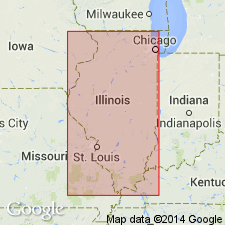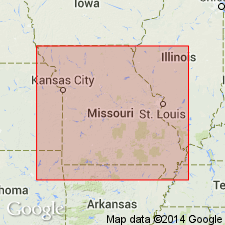
- Usage in publication:
-
- Hazelwood member
- Modifications:
-
- Original reference
- AAPG geologic province:
-
- Wisconsin arch
Summary:
Figs. 3, 10, 16. Hazelwood member of Mifflin formation. Limestone, thick-bedded; dolomite, pure, nonshaly, medium-bedded. Thickness 5 to 7 feet. Shown on columnar section as underlying Briton member (new) and overlying Establishment member (new). Age is Middle Ordovician.
[Notable exposures in Dixon-Oregon area, northern IL.]
Source: US geologic names lexicon (USGS Bull. 1200, p. 1715).

- Usage in publication:
-
- Hazelwood member
- Modifications:
-
- Not used
- AAPG geologic province:
-
- Wisconsin arch
Summary:
The Hazelwood Member of Mifflin Formation of Plattin subgroup [informal] of Templeton and Willman (1963) = lower part of Beckett Limestone of Plattin subgroup. Age is Ordovician (Mohawkian).
["Subgroup" not recognized as a formal stratigraphic rank term (CSN, 1933; ACSN, 1961, 1970; NACSN, 1983, 2005, 2021). Considered informal and should not be capitalized.]
Source: Publication.
For more information, please contact Nancy Stamm, Geologic Names Committee Secretary.
Asterisk (*) indicates published by U.S. Geological Survey authors.
"No current usage" (†) implies that a name has been abandoned or has fallen into disuse. Former usage and, if known, replacement name given in parentheses ( ).
Slash (/) indicates name conflicts with nomenclatural guidelines (CSN, 1933; ACSN, 1961, 1970; NACSN, 1983, 2005, 2021). May be explained within brackets ([ ]).

